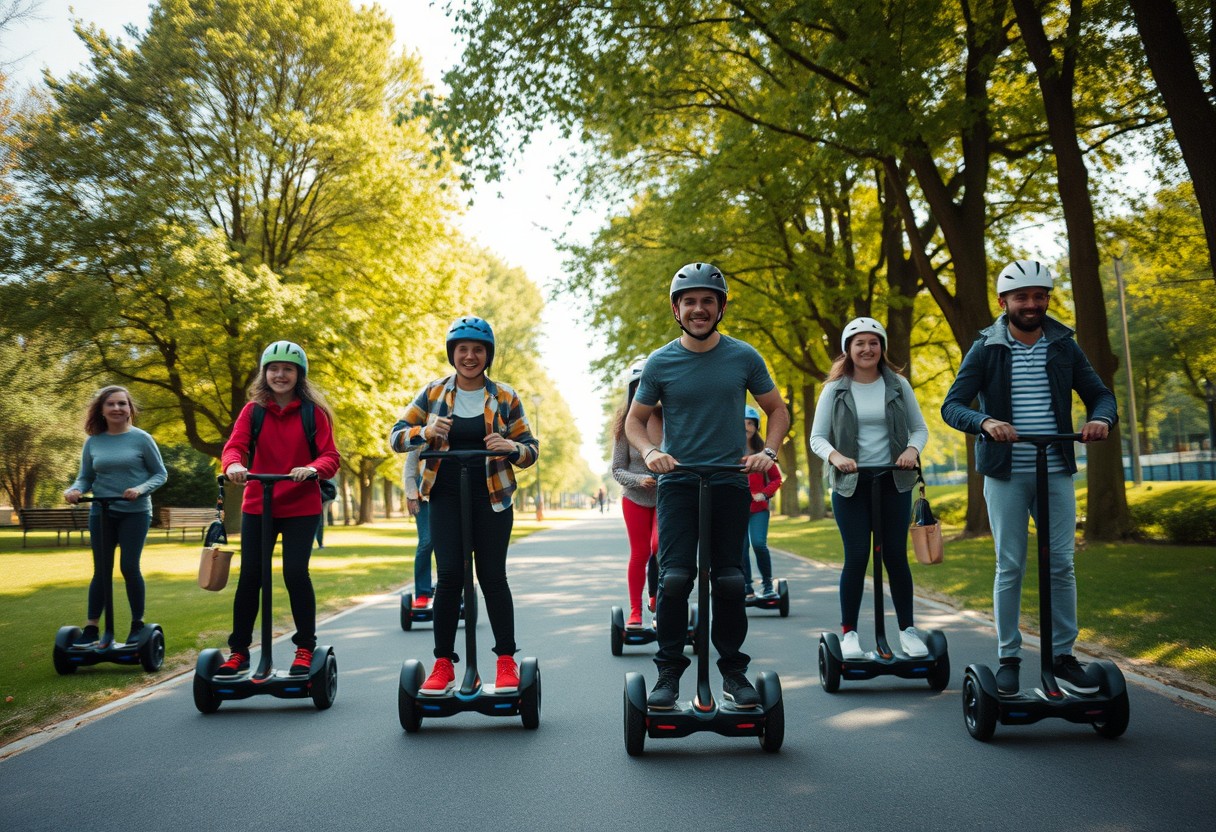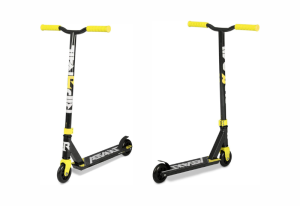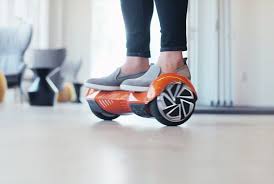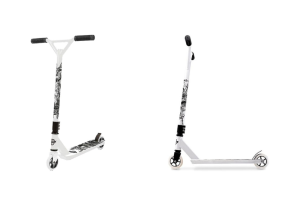With the increasing popularity of hoverboards, it’s crucial for you to prioritize safety while riding. Understanding the risks associated with these devices can help you avoid serious injuries and enjoy a rewarding experience. You should always wear appropriate safety gear, such as a helmet and knee pads, and ride in designated areas to ensure your safety and the safety of others. This blog post will share vital tips and best practices to keep you safe on your hoverboard, so you can have fun without compromising your well-being.
Table of Contents
ToggleUnderstanding Hoverboard Safety
A key component of enjoying your hoverboard experience is gaining a comprehensive understanding of safety measures. The increased popularity of hoverboards has not only made them a trendy mode of transportation but has also emphasized the importance of recognizing potential hazards and learning how to mitigate risks effectively.
The Evolution of Hoverboards
For many, hoverboards conjure images of futuristic transportation, but their evolution has been grounded in technological advancements over the years. Initially introduced as two-wheeled self-balancing scooters, modern hoverboards have incorporated more sophisticated mechanisms and safety features, making them more appealing to a wider audience also you can find more information from here Top 10 Hoverboard Brands You Can Trust
As hoverboards have evolved, manufacturers have had to respond to various safety concerns that emerged. Features such as better battery management systems, sturdy materials, and advanced gyroscopic technology have vastly improved their reliability and safety, thus making your hoverboarding experience much more enjoyable.
Common Types of Hoverboards
Any hoverboard enthusiast should be familiar with the different types available on the market today. These can vary in terms of design, functionality, and **safety features**. Understanding these distinctions can help you choose the right one for your needs while ensuring you prioritize safety.
| Type | Features |
| Classic Hoverboards | Basic design, suitable for beginners. |
| All-Terrain Hoverboards | Designed for rugged surfaces, higher battery capacity. |
| Slightly Larger Models | More stability due to wider footpads and larger wheels. |
| Smart Hoverboards | Connected to apps for tracking performance and battery life. |
| Safety-Enhanced Models | Include additional features like LED lights and protective casings. |
- Classic Hoverboards offer a straightforward and intuitive ride.
- All-Terrain Hoverboards can handle various surfaces without losing balance.
- Slightly Larger Models provide more stability, especially for beginners.
- Smart Hoverboards connect to your devices for a tech-savvy experience.
- Safety-Enhanced Models come with advanced features to protect you while riding.
After reviewing the common types of hoverboards, it’s clear that selecting the right model can greatly influence your experience and overall safety.
How Hoverboards Work
Work begins with the core components of a hoverboard, which include sensors, motors, and batteries. When you lean forward, sensors detect your movement, prompting the motors to propel you in that direction. Balancing is an automatic function, thanks to gyroscopic technology that constantly adjusts the board to keep you upright.
The smooth operation of hoverboards relies heavily on their battery systems. A high-quality battery not only ensures longevity but also plays a crucial role in delivering power efficiently. Therefore, being aware of how to charge and maintain your hoverboard is vital for ensuring your safety while using it.
Types of hoverboards can influence how they work and respond to your movements. For example, **all-terrain boards** often come with enhanced wheels and stronger motors, allowing them to navigate bumpy surfaces more effectively, while **smart boards** have advanced functionalities like app connectivity for enhanced control and monitoring. Understanding your hoverboard’s unique capabilities can significantly enhance your riding experience and keep you safer.
| Component | Function |
| Sensors | Detect movements and changes in balance. |
| Motors | Provide the power needed to propel and steer the hoverboard. |
| Batteries | Store and supply energy for operation. |
| LED Lights | Enhance visibility, especially in low-light conditions. |
| Wheels | Interface with surfaces and assist in the hoverboard’s maneuverability. |
- Sensors allow for smooth operation by detecting your balance and adjustments.
- Motors are crucial as they provide the necessary power to propel you.
- Batteries directly influence the performance and duration of your rides.
- LED Lights are vital for safety in darker conditions.
- Wheels determine the grip and stability of your ride.
After grasping how hoverboards operate, you’ll appreciate their technology and the need to be cautious while riding.
Essential Safety Equipment
It is crucial to equip yourself with the proper safety gear to ensure a safer riding experience on your hoverboard. Not only does this equipment help to protect you from injury, but it also enhances your confidence while you ride. Below, you’ll find important pieces of safety equipment that every hoverboard rider should consider:
| Safety Gear | Details |
|---|---|
| Helmet | Provides head protection and reduces the risk of serious injury during falls. |
| Knee and Elbow Pads | Protect your joints in the event of falls or collisions. |
| Wrist Guards | Guard against sprains and fractures in your wrists. |
| Appropriate Footwear | Ensure good grip and support while riding your hoverboard. |
| Reflective Gear | Increases visibility, particularly during low-light conditions. |
Helmets: Types and Features
It is imperative to wear a helmet while riding your hoverboard to protect your head from any unexpected accidents. There are various types of helmets available, including full-face helmets, skateboard helmets, and bike helmets. Each type offers different levels of coverage and protection, so you should consider which one suits your needs best. Look for features like ventilation, adjustable straps, and removable padding for comfort and safety.
Some popular features to consider when selecting a helmet include:
- Impact Resistance – Ensures your helmet can absorb the shock from a fall.
- Lightweight Materials – Offers comfort during extended use.
- Size Adjustability – Provides a secure fit for better protection.
- Visors – Helps keep your vision clear from debris and sun.
- Certification – Look for a helmet with safety certifications like CPSC or ASTM.
Any helmet you choose should balance good protection with comfort to encourage consistent usage.
Knee and Elbow Pads
The importance of knee and elbow pads cannot be overstated, as these pads protect vital joints during a fall. Made of high-density foam and durable plastic, they absorb shock and prevent scrapes and bruises. When opting for knee and elbow pads, look for options with adjustable straps to ensure a snug fit and breathability to keep your skin dry.
A good rule of thumb is to invest in pads that feature a hard shell exterior for added protection against impacts, coupled with softer inner padding for comfort. This combination will help you maintain mobility while ensuring your joints stay safe during your hoverboarding sessions.
Wrist Guards
One important piece of safety gear often overlooked is the wrist guard. When riding a hoverboard, the risk of falling and placing undue pressure on your wrists is high. Wrist guards are designed to provide support and prevent sprains or fractures associated with sudden falls. Choose guards that are specifically designed for action sports, as they often feature a sturdy yet flexible construction.
Plus, when wearing wrist guards, make sure to choose a pair that allows for a full range of motion while still offering ample support. This balance ensures that you can ride confidently without sacrificing the protection your wrists need during unexpected incidents.
Appropriate Footwear
Features such as grip, ankle support, and comfort are vital in choosing appropriate footwear for hoverboarding. It’s important to wear shoes that provide traction to help prevent slipping off the board. Sneakers with a flat sole are often recommended, as they allow for better balance and control while riding.
Safety should always be your priority, and wearing suitable footwear minimizes the risk of injury while ensuring you have the best riding experience made possible by increased stability. This type of footwear will not only protect your feet but will also enhance your performance on the hoverboard.
Safe Riding Practices
Your safety while riding a hoverboard starts with adopting safe riding practices. These practices not only ensure that you enjoy your experience but also protect you from potential accidents. By implementing these strategies, you can minimize risks and maximize enjoyment while riding.
Choosing a Safe Riding Environment
One of the key aspects of hoverboard safety is to select a suitable riding environment. Look for areas that are flat, smooth, and free of obstacles. Avoid crowded spaces, busy streets, or any area where you might encounter unpredictable elements such as pedestrians, pets, or vehicles. An ideal location can significantly reduce your risk of falling or colliding with others.
Additionally, consider the weather conditions. It’s best to avoid riding in wet, icy, or windy conditions, as these can affect your board’s balance and your ability to maneuver. By choosing a safe environment, you create an optimal experience that supports your learning and comfort on the hoverboard.
Learning to Balance and Steer
With every ride, mastering your balance and steering is crucial. When you first step onto your hoverboard, it’s important to get comfortable with the way it responds to your movements. Keep your feet shoulder-width apart and distribute your weight evenly to maintain your balance. Initially, practice in a controlled environment where you can focus solely on getting used to the board.
Learning to steer involves shifting your weight in the direction you want to go. For instance, lean slightly forward to accelerate and lean back to slow down or stop. The more you practice these movements, the more confident and skilled you will become. Remember that patience and practice are the keys to mastering your hoverboard.
Learning this necessary skill through gradual practice will provide you with confidence during your rides. Start by riding in a straight line and gradually introduce turning techniques, ensuring you maintain a relaxed posture as you steer.
Speed Management
Riding at appropriate speeds is vital to ensure your safety. Hoverboards can reach impressive speeds, and while it’s exhilarating, speed management is necessary. Begin riding at a slow, controlled pace until you feel comfortable and confident in your ability to steer and balance. Gradually increase your speed as you become more experienced, paying attention to your surroundings.
Keep in mind that quick stops can be difficult, especially when riding at high speeds. To maintain control, practice slowing down before incoming turns or obstacles, rather than abruptly stopping. Being aware of both your speed and the surrounding environment helps to enhance your overall safety.
It’s necessary to always be mindful of your speed, especially in varying environments. Riding too fast in crowded places significantly heightens the risk of accidents, making it crucial to adjust your speed according to your surroundings.
Avoiding Distracted Riding
An equally important factor to hoverboard safety is avoiding distractions while riding. Stay focused on your surroundings and refrain from using your phone or other devices while operating the hoverboard. Distractions can impair your judgement and reaction times, leading to accidents that could be easily avoided with your full attention.
Establish a routine before you launch on a ride—double-check your gear, ensure your board is in good condition, and clear out any potential distractions. By fostering a focused mindset, you will pave the way for a safer riding experience.
Riding should be an enjoyable experience, but being aware of your surroundings and avoiding distractions is fundamental. Make the commitment to prioritize your attention, and you will significantly reduce the risk of mishaps on your hoverboard.
Maintenance and Inspection
Despite the excitement and fun that comes with riding a hoverboard, it is crucial to prioritize maintenance and inspection to ensure your safety and that of others around you. Regular upkeep can prolong the life of your hoverboard, enhance its performance, and ultimately prevent accidents caused by wear and tear. By taking time to check your device routinely, you can identify issues early on and address them before they become serious problems.
Regular Battery Checks
One of the most important aspects of hoverboard maintenance is conducting regular checks on your battery. Hoverboards rely on lithium-ion batteries, which can be sensitive to environmental conditions and usage patterns. Ensure that you are periodically looking for any signs of damage, swelling, or leaking, as these can indicate that the battery is compromised and poses a serious safety risk. It’s advisable to charge your battery only with the charger provided by the manufacturer to avoid overcharging and overheating.
Additionally, you should keep an eye on the battery’s charge level before each ride. Running a hoverboard with a low battery can lead to unexpected power losses, which can result in loss of control. Make it a habit to fully charge before your rides and avoid letting the battery drain completely, as this could diminish its lifespan.
Tire Maintenance
Regular tire maintenance is crucial for your hoverboard’s performance and safety. Check the tire pressure frequently and ensure it is within the recommended range specified by the manufacturer. Under-inflated tires can lead to poor handling and increase the risk of flats, which may cause accidents and injuries.
The condition of your tires is also significant. Inspect for any wear and tear, such as cracks or punctures, that could compromise your ride. If you notice any irregularities in the tread, it may be time to replace them to maintain adequate grip and ensure safe maneuverability.
Electronic Component Safety
Inspection of electronic components is another critical aspect of hoverboard maintenance. Regularly examine the wiring, lights, and control panels for any signs of damage or wear. Loose or exposed wires can not only affect the functionality of your hoverboard but can also lead to electrical shorts that may pose a fire hazard. Make sure to address any discrepancies immediately to avoid major incidents.
A thorough check of your hoverboard’s electronic systems will also contribute to the overall efficiency of your ride. All systems must function properly; if you notice any irregular responses, such as the hoverboard not turning on or erratic behavior while riding, it is imperative to have the device professionally serviced. Regular maintenance ensures that you can enjoy your rides without concern.
Cleaning the Hoverboard
Component cleanliness is often overlooked but is vital for maintaining your hoverboard. Regularly wipe down your hoverboard’s exterior with a damp cloth to remove dust, dirt, and any debris that may have accumulated. Pay particular attention to the sensors and wheels, as grime buildup can seriously affect performance and responsiveness.
Battery terminals should also be cleaned gently with a dry cloth to prevent buildup that could interfere with charging. You should avoid exposing your hoverboard to water or submerging it, as this can damage the internal electronic components, leading to expensive repairs. Keeping your hoverboard clean not only maintains its aesthetic appeal but also enhances its functionality.
Understanding Hoverboard Regulations
Now that you’re excited about hopping on a hoverboard, it’s important to understand the laws and regulations that govern hoverboard use. Local regulations can vary significantly, so it’s crucial to research the specific laws in your area. Many regions have regulations that dictate where you can ride hoverboards, as well as requirements for safety gear such as helmets and knee pads. For more comprehensive information, you can refer to Hoverboards | Children’s Hospital of Pittsburgh, which discusses various safety-related matters. Ignoring these regulations can not only result in fines but can also put you at increased risk of injury.
Local Laws and Restrictions
Hoverboard usage is often restricted to specific areas, and some places may prohibit their use entirely on sidewalks, bike paths, or streets. For example, many cities have implemented rules that may require riders to stay within designated areas or may limit hoverboard use to private property. You should always check your local jurisdiction for specific guidelines to avoid any legal complications.
In some regions, hoverboards may be classified as “electronic personal transportation devices.” As such, they may be subject to various traffic laws that can include speed limits, licensing, and registration. Knowing these rules helps ensure that you enjoy your hoverboard safely and responsibly.
Age Restrictions and Recommendations
Recommendations for hoverboard use also vary by age group. Manufacturers often suggest that hoverboards are suitable for individuals aged 8 and above, but it’s important to ensure that younger riders can handle the responsibilities and challenges that come with hoverboarding. Proper supervision is also crucial for younger age groups to ensure their safety while riding.
Understanding the age restrictions will enhance your hoverboard experience, making it fun and safe. These guidelines are designed to ensure that individuals are both physically and cognitively equipped to handle the control and balance necessary for riding.
Riding on Public vs. Private Property
The distinction between riding on public and private property is vital when it comes to hoverboard regulations. Riding on private property generally has fewer restrictions; however, you should ensure that you have permission from the property owner. In contrast, riding on public property often falls under stricter laws, and you must adhere to local regulations that may include limitations on where you can ride, as well as helmet requirements.
Regulations for public areas often include designated riding zones, similar to those for bicycles and other wheeled devices. Understanding where hoverboards are permitted helps you navigate your riding experience and avoid situations that could lead to fines or accidents.

Common Injuries and Prevention
To minimize the likelihood of accidents while hoverboarding, it’s necessary to understand the types of injuries that commonly occur. With the rapid growth in popularity, hoverboards can pose risks to both novice and experienced riders alike. Developing a clear understanding of these injuries not only assists in prevention, but also helps you respond effectively if an accident does occur.
Types of Injuries Associated with Hoverboarding
Any hoverboard enthusiast should be aware of the potential injuries that can arise from riding. Common injuries include:
| Wrist fractures | Usually caused by bracing for a fall. |
| Sprained ankles | Often result from losing balance or improper foot placement. |
| Head injuries | If you fall, a lack of helmet protection could lead to serious consequences. |
| Knee injuries | These occur when sudden stops cause strain. |
| Road rash | Can happen from falling onto rough surfaces, making protective gear necessary. |
After understanding these injuries, you can take steps to mitigate them through appropriate safety measures and equipment.
Understanding Risks
Associated with hoverboarding, the risks vary significantly based on your skill level, the terrain, and the safety gear you choose to use. Varied environments pose differing challenges; for example, riding on smooth surfaces may have fewer risks compared to rough terrain with potential obstacles. Additionally, using a hoverboard without being adequately trained or familiar with its operation can lead to unfortunate consequences.
Injuries can occur at any moment, reminding you that constant vigilance is imperative. The combination of high speeds and unsteady balance means that even the most skilled rider is at risk. Always remain aware of your surroundings and prioritize safety by wearing protective gear such as helmets, knee pads, and wrist guards.
First Aid for Hoverboard Injuries
First aid knowledge is crucial for addressing injuries that may occur while hoverboarding. In the event of an accident, promptly assess the injury and treat accordingly. For minor injuries like scrapes or bruises, clean the area with soap and water, and apply a sterile bandage to protect the wound. In cases of sprains or strains, rest, ice, compression, and elevation (R.I.C.E.) can significantly aid in recovery.
Understanding how to respond quickly and effectively can mean the difference between a minor setback and a more serious condition. If you experience extreme pain or swelling, you should consider seeking professional medical advice.
When to Seek Medical Attention
The decision to seek medical attention depends heavily on the severity of your injury. If pain persists or worsens, or if you notice abnormal swelling and bruising, it is best to consult with a healthcare professional. Additionally, if you experience any *symptoms of a concussion*, such as persistent headaches, confusion, or balance issues, it’s crucial to seek medical evaluation immediately.
Seek help promptly if you suspect serious injuries such as fractures or head injuries. Obtaining the right medical care can result in a faster recovery and prevent further complications.
To wrap up
Upon reflecting on hoverboard safety tips, it is important for you to recognize the importance of prioritizing your safety and that of those around you while enjoying this exciting mode of transportation. By adhering to guidelines such as wearing appropriate protective gear—including helmets, knee pads, and elbow pads—you significantly reduce your risk of injury. Additionally, being aware of your surroundings, choosing safe riding locations, and avoiding overcrowded or uneven terrains can lead to a much more enjoyable and secure riding experience.
Moreover, staying updated on your hoverboard’s specifications and maintenance requirements is crucial for ensuring its safe operation. Always check for any recalls on your device and ensure your hoverboard is certified for safety standards. By taking these simple precautionary measures, you can confidently and responsibly enjoy the thrill of hoverboarding while safeguarding your well-being. Your awareness and proactive approach to safety not only enhance your experience but also set a positive example for other riders.
FAQ: Hoverboard Safety Tips – What You Need to Know
Q: What are the imperative safety tips for riding a hoverboard?
A: To ensure a safe riding experience, consider the following tips:
1. Always wear protective gear, including a helmet, knee pads, elbow pads, and wrist guards.
2. Ride on flat, dry surfaces to avoid slipping and losing balance.
3. Start in an open area free of obstacles or traffic to practice your balance and control.
4. Avoid riding in inclement weather, particularly on wet or icy surfaces.
5. Follow weight limits specified by the manufacturer to prevent malfunctions.
Q: Is it safe for children to ride hoverboards?
A: Hoverboards can be safe for children if they are supervised and wear appropriate safety gear. It is imperative to choose a hoverboard that suits the child’s age and size. Parents should set clear rules for riding, ensuring that children practice in safe environments away from traffic and obstacles.
Q: How can I maintain my hoverboard for safety?
A: Regular maintenance is crucial for safe riding. Here are some maintenance tips:
1. Check tire pressure regularly and ensure tires are in good condition.
2. Inspect the battery and charger for any signs of wear or damage.
3. Clean the hoverboard to remove dirt and debris that could impact performance.
4. Store the hoverboard in a dry place to prevent water damage.
5. Follow the manufacturer’s instructions for servicing and repairs.
Q: What should I do in case of a hoverboard malfunction?
A: If your hoverboard malfunctions, follow these steps:
1. Immediately stop riding to avoid injury.
2. Place the hoverboard in a safe area away from people and traffic.
3. Check for visible signs of damage, such as frayed wires or cracks.
4. If problems are detected, do not attempt to ride it again; consult the manufacturer’s guidelines or seek professional repair services.
5. If the hoverboard catches fire, evacuate the area and call emergency services.
Q: Are there any age restrictions for hoverboard riders?
A: While there may not be formal age restrictions, many manufacturers recommend hoverboards for riders aged 8 and up. It is important to assess the rider’s maturity level, physical ability, and experience with balance and coordination before allowing them to ride. Parent supervision and guidance are imperative for younger riders to ensure safety.







